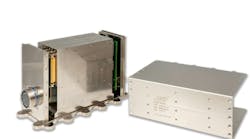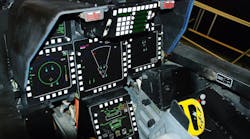VITA 46: a smart new set of wheels for a proud VMEbus tradition
I read with interest your column “Beware the siren song of VITA 46” (January 2005, p. xx). To the ancient Greeks, the song of the sirens was the most beautiful and alluring sound in the whole world. Of course, nowadays we download siren songs in mp3 format by the gigabyte, and nobody has to be tied to the masthead for listening to them (yet, but the RIAA may be considering it…).
Just as the ancient world is very different from our own, so too are the needs of today’s military electronics very different from those of the 1980s. VITA 46 encompasses three paradigms - high speed I/O to the backplane, serial-switched fabrics, and VMEbus.
Yes, I did just say VME. VITA 46 is as much about carrying forward customers’ existing investment in VME boards - especially military boards with P-zero connectors - as it is about new technology. The VME parallel bus has not gone away, disappeared, or been run over by a big Kenworth; it has simply been given a smart new set of wheels in the form of a new high-speed connector. Yet by also embracing DVI, S-ATA, 10 Gigabit Ethernet, and serial-switched fabrics, VITA 46 continues a proud VMEbus tradition, that of adapting and adopting the latest technologies while retaining existing investment. If you like, it’s a remarkable beast - an iPOD that not only plays today’s mp3s and CDs, but plays all your old vinyl albums as well. Now there’s a compelling idea!
David Compston
Director of Marketing
Radstone Embedded Computing
Towcester, England
A different perspective on VITA 46
I, and undoubtedly many others, read with great interest your article on the subject of VITA 46, “Beware the siren song of VITA 46” (January 2005, p. XX). At Curtiss-Wright Controls Embedded Computing (CWCED) we would agree with the notion that program managers, systems integrators, and decision makers in general must be careful to choose the technology that is best for a given application. Being a leading supplier of VME and Compact PCI for the military and aerospace industry, CWCEC would also be the first to attest to the tremendous utility that these parallel buses have provided to the industry over the past many years and promise to provide into the future with our continued stream of new VME64x products.
There are, however, some areas of your article on which we have some very different perspectives. Certain of the comments regarding fabrics, for example, “wholesale adoption of switched fabrics would be a miscalculation,” “switched fabrics . . . could be a train wreck going somewhere to happen,” “engineers will get deep into the fabrics and realize they have three years of software to write and certify” seem not to have taken into account the reality that fabrics are already being used extensively, and successively, in mil/aero systems. Examples include StarFabric, Raceway, and Gigabit Ethernet. Typically these fabrics are used as adjuncts to a parallel bus, most often VME.
Newer fabrics such as Serial RapidIO, PCI Express, Advanced Switching, 10 Gigabit Ethernet, and Infiniband are emerging from the global IT world and promise even higher performance and lower costs, which will let systems integrators tackle ever-more-challenging requirements. These new fabrics all work at multiple gigabit-per-second rates. In addition to the fabrics, I/O is moving to high-speed serial as witnessed by standards such as Serial ATA, Serial Attached SCSI, digital video, serial FPDP, RocketIO, etc. Accommodating all this high-speed serial connectivity, whether for fabric or for I/O, is where VITA 46 comes in. It provides as many as 192 high-speed differential pairs capable of carrying signals at rates as fast as 6.25 GHz, and provides the option for a parallel bus such as VME for use as the control bus.
In your article you make the statement “There’s a lot at stake here.” No doubt the VITA 46 working group would agree, and that is why they set to work to develop a very forward-looking standard while simultaneously defining details of the format such as an alignment and keying system that will all but eliminate pin breakage, defining PMC and XMC mappings (including differential pairings up front to maximize multi-vendor interoperability, and developing a comprehensive connector and module environmental test plan to allow vendors and systems integrators to use the standard with confidence in harsh-environment applications. Good progress is being made by the VITA 46 Working Group and 2005 will see finalization of the standards and first-product announcements.
John Wemekamp
Chief Technology Officer
Curtiss-Wright Controls
Embedded Computing
Kanata, Ontario
[email protected]
VMETRO dominates board-based data-recording market
I was surprised and disappointed to see no mention of VMETRO Transtech in your recent article “Hard drives rule for military storage” (December 2004, p. XX). You may not be aware of it, but VMETRO Transtech dominates the rugged, board-based data-recording market and we do very well in the stand-alone data-recorder market as well.
As you would expect our extensive experience with rugged data recording applications makes us experts in many forms of ruggedized storage media utilizing rotating and solid-state disks. In fact, VMETRO sells and deploys most of the storage media types discussed in your article on a routine basis. Some examples include commercial Fibre Channel JBOD on ASTOR, sealed and shock-isolated ATR JBOD on U-2 AIP, and solid-state drives in the Cobra helicopter.
VMETRO Transtech is distinguished from many competitors because we work with storage vendors to qualify storage devices before using them in our recorders. This qualification includes validating the firmware version being used in the storage device and certifying that it is appropriate for the sustained high-speed demands of continuous data recording.
With an extensive range of capabilities that include sustained high-bandwidth data recording, real-time determinism, easy performance and capacity scaling, storage virtualization, signal reproduction, simultaneous recording and signal reproduction, as well as enterprise accessibility to recorded data, VMETRO Transtech is uniquely qualified to meet the tough requirements of the military and aerospace market.
In closing, we appreciate Military & Aerospace Electronics because of the opportunity it provides us to keep in touch with our market and customers, and we hope that you will remember us in future articles dealing with storage, data recording, and/or real-time systems.
Ronnie Sanford
Marketing Manager
VMETRO Transtech
Houston


